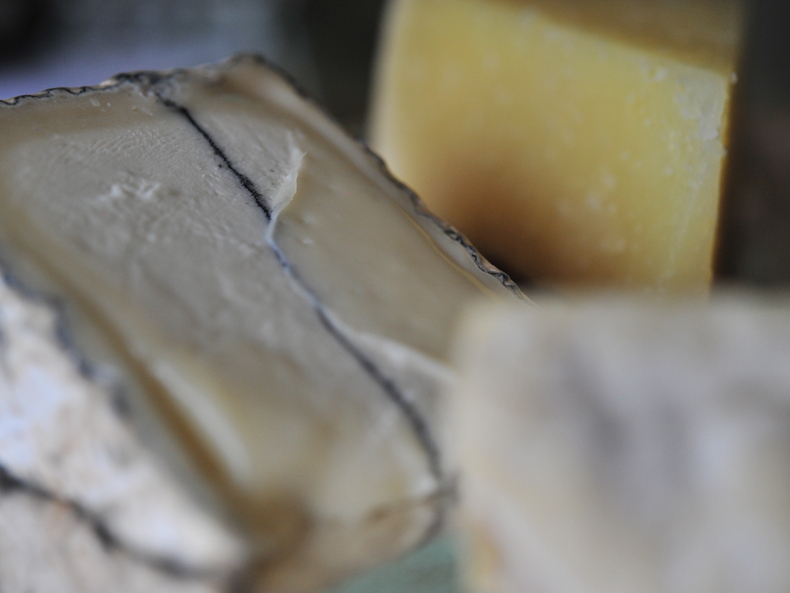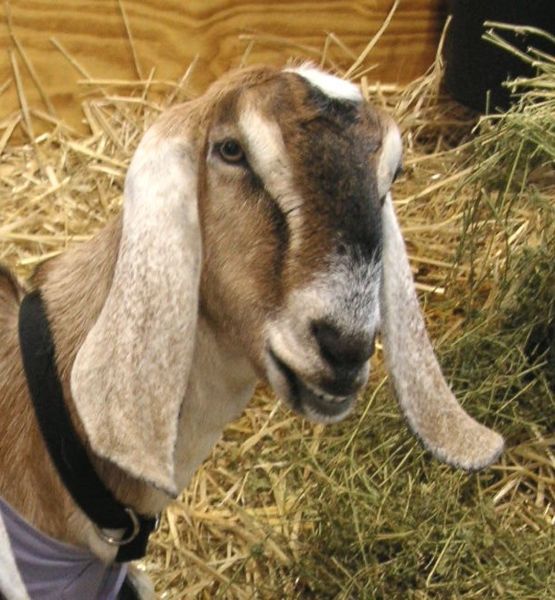2.3.10 Ruminating (Goat vs Cow)

photo by george billard
One of the many nice things I've discovered in moving up to the country is that I can do a bit more ruminating. Not in the most literal sense, of course. I've only got one stomach (although sometimes it may look like two). And unlike cattle, goats, sheep, giraffes, bison, yaks, water buffalo, deer, camels, alpacas, llamas, wildebeest and antelope (I love lists), I am not required to chew my cud. But I do find that I now have time to tromp up an abandoned fire road in the rose-colored dusk, side-stepping slick patches of ice; or stare into the fire mesmerized as I absently stroke the cat's underfluff; or lie on the couch in a rare pool of afternoon sunshine, daydreaming of shallot-beef broth with cheese dumplings or buckwheat crepes or lemon soufflé (all three coming soon, I promise). And during those moments, I can turn a few thoughts over in my mind. Like common pebbles in a tumbler, they start to lose their rough edges, give off a greater luster. Maybe. Anyway, one of the things I've lately been runimating on, if you will, is my estrangement from cow's milk.

a nubian goat
Mind you, I was never fond of a big glass of milk. Handed a big slice of chocolate cake or a peanut butter sandwich, I would much rather have a cup of tea. But I do have a certain weakness for creme fraîche—cream of all sorts, for that matter. Half-&-half and whipped cream really can't be replaced by anything made from goat's milk or sheep's milk or hemp or rice or soy either. When I found that eating cow's milk products—milk, ice cream, cheese, even yoghurt—left me with a sour stomach and gas quite often, I gradually switched to the other ones I mentioned. And I've never switched back. Since I'm not a fascist about it, I do still eat Parmigiano Reggiano (the king of cheese!) and when I need cream, I have it. But the world of ruminants is rich and diverse, and so are the amazing products that emerge from it.Part of the problem with the milk products available today in North America is that virtually all must be pasteurized in order to be legal to sell. This process denatures proteins, destroying enzyme activity, which most likely leads to a change in how the food is digested. It also robs the milk of much of its nutritional value. (And what about flavor?!) A sensitivity to cow’s milk products (telltale signs can be gas, bloating, acidity, mucus formation) may be related to acne, asthma, eczema, congestion, rheumatoid arthritis, inflammation, recurrent ear infections, degenerative illnesses, yeast (candida) and systemic acidity. Wouldn't you consider reducing/eliminating your cow's milk intake to alleviate these hideous conditions and improve your health?Many people who cannot tolerate cow's milk are able to drink goat's milk without any problems. This may be because specific proteins known to cause allergic reactions that are present in cow's milk in significant quantities are largely absent in goat's milk—the same alpha-casein proteins that are removed from ghee. Some research has found certain anti-inflammatory compounds to be present in goat's milk. These may make goat's milk easier to digest, especially in the case of compromised intestinal function. In animal studies, goat's milk has also been shown to enhance the metabolism of both iron and copper, especially when there are problems with absorption of minerals in the digestive tract. These factors and others are likely to play an important role in the tolerability of goat's milk versus cow's milk. Plus goat’s milk contains less fat and smaller fat globules than cow’s milk which also makes it easier to digest. On top of all this, goat's milk is a very good source of calcium, protein, phosphorus, riboflavin (vitamin B2), potassium and the amino acid tryptophan. By the way, the same holds true for sheep's milk, which also contains even more conjugated linoleic acid (CLA), a cancer-fighting, fat-reducing fat.Did I mention it tastes wonderful? It's light and sweet, with the earthy, grassy undertones you'll recognize from goat cheese. At the farm up the road, newborn baby goats have leapt into my arms for cuddling, their silky white coats emanating a light fragrance that conjures up that same flavor. Last year, I read a fantastic book by Brad Kessler called Goat Song: A Seasonal Life, A Short History of Herding, and the Art of Making Cheese that I highly recommend. It is an ode to the goat in all its age-old splendor, debunking some of the myths (they do not eat tin cans) and illuminating many fascinating traits (not to mention a highly charged sex life). Although I have yet to eat cheese from my own goats, I can say that our fridge now holds milk, cheese, butter and yoghurt from local goats (some closer than others). And in our freezer, you can often find a pint of La Loo's goat's milk ice cream! The Deep Chocolate made with Scharffen Berger is rich and delicious. If you can't find La Loo's near you (they are sold at Whole Foods), you can order online to be shipped anywhere! I'm dying to try their Cajeta Frozen Yoghurt which I've never seen in the store.So the next time you're in the dairy section, promise me you'll give goats and sheep a whirl. Need more inspiration? Here are some of my all-time favorite non-cow cheeses. Bear in mind that fresh goat cheese is best in spring and early summer, when the goats are grazing on green herbs and grasses.Humboldt Fog (pictured above) - a creamy, tangy goat with a ribbon of edible vegetable ash from Cypress Grove, a California company that produces many fine goat cheesesFleur Verte - fresh goat wrapped in tarragon and crushed pink peppercornsNevat - soft-ripened goat from Spain (geek out on this video)Queso Leonora - another goat from Spain; tangy, firm-crumbly and irresistiblePecorino - a sharp, dry oily sheep; my favorite is a Sicilian version made with saffron and peppercornsGoat Gouda - either the young, tender one or the drier, aged one with notes of caramelManchego - the classic Spanish sheep, to eat with membrillo (quince paste)Roquefort - the pinnacle of blue cheeses, always made with sheep; for a local version try the award-winning Ewe's Blue from Old Chatham Sheepherding CompanyDean & Deluca (aka The Demon) has a lot of great cheeses; as does Murray's; but for cheeses lovingly and artfully selected from local farms, pay a visit to Anne Saxelby at the Essex Street Market in New York City. You can also order from her website, which offers an inspiring collection of farmstead cheeses, including some raw milk varieties.






1 Comment